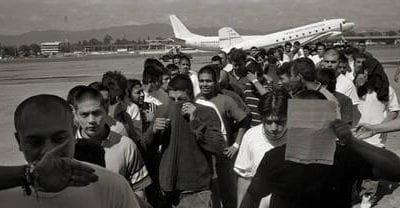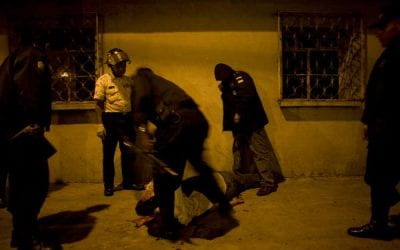Keys to Reducing Violence in Mexico
Targeted policing and civic engagement
Some regions of Mexico now seem like war zones. Nineteen out of the 50 most violent cities in the world are expected to be found in the country by the end of 2011. Yet severe violence is concentrated in a handful of key transit regions near the border and coasts. The crucial cocaine corridor from Ciudad Juarez into the United States experienced homicide rates of 216 victims per 100,000 inhabitants in 2010.
During the last four and a half years, 41,648 killings have been officially linked to drug trafficking organizations, a dramatic increase from the previous five years when only 8,901 were registered. In 2010, the grisly sum reached a record 15,273 or 47 percent of all violent deaths (Rios, Viridiana and David Shirk 2011 “Drug Violence in Mexico: Data and Analysis Through 2011” Trans-border Institute (TBI) February 2011).
Taming violence is a daunting task for the Mexican authorities. Nonetheless, President Calderón’s policies have had some success, such as the precipitous reduction in violence recorded in Tijuana and ongoing challenges in Juarez. Mexico and other states that have reduced violence offer lessons. Governments obviously need to improve the capacity of law enforcement institutions, provide adequate human and material resources, and garner political support to sustain targeted policies through the ineluctable setbacks that plague even the best campaigns. We focus on some less obvious lessons drawn from efforts to reduce violence in Mexico and beyond. In particular, we stress the effectiveness of targeted hot spot tactics and collaboration between state authorities and civil society. It appears, too, that the criminal community itself must have organizational cohesion for policies to produce fast effects.
In Mexico, Tijuana is the most vivid example where government policies contributed to a successful decrease in drug-related bloodshed. Violence spiked in the border town when a faction of the Tijuana cartel separated and joined forces with the Sinaloa cartel to take over the territory. This turf battle caused 408 homicides in the final three months of 2008, which made Tijuana one of the nation’s most violent cities. However, by the first trimester of 2009 homicides dropped dramatically. Conditions in Tijuana improved while those in Juarez deteriorated.
Observers attribute improved conditions in Tijuana to coordinated enforcement efforts by federal, state, and local forces to regain control of the city’s most dangerous areas. Critically, this strategy promoted trust between civil society and government authorities. Officials purged the municipal police and encouraged anonymous tips about criminal events by members of the public to the army. This decision promoted good will with the populace that distrusted the police and held the army in higher esteem. With information flowing between the populace and authorities, officials targeted the newly separated cartel fraction. Tijuana was divided into quadrants and the government implemented tactics to pacify them piecemeal. The leader of the renegade faction fled Tijuana to La Paz, a resort town at the southern end of the Baja peninsula, where authorities arrested him.
The tactics adopted in Tijuana parallel successful efforts elsewhere in the world. Authorities in Tampa, Florida, deployed similar methods to reduce violence by 75 percent between 1986 to mid-1988. With the help of civil society, the police department acquired the capacity to track drug-dealing operations that were moving too fast for authorities to monitor with conventional patrolling and intelligence. As in Tijuana, a just-in-time communication system of anonymous denunciation contributed to the reversal, as did focusing on visible key hot spots of criminal activity.
About a decade ago, civil society participation was also crucial in Colombia with its policy of “hometown soldiers” (soldados de mi pueblo) policy. Soldiers were assigned to serve in their home communities rather than random locations. This approach boosted trust in the security forces and increased citizen cooperation, which in turn facilitated enforcement and contributed towards dramatic reductions in violence. In Rio de Janeiro, targeted enforcement efforts— considered important innovations in policing. They helped to reduce violent deaths from 44 per 100,000 habitants to 15 between 1999 and 2007. The combination of targeted hot spot tactics and promoting trust between civil society and the authorities were also instrumental in obtaining significant reductions of violence in Bogotá and Medellin, as well as in Boston in the United States.
These examples suggest that success depends on enforcement strategies and, crucially, on the structure of criminal organization. They indicate that the effects of hot spot tactics and civil society cooperation were effective when the authorities faced cohesive criminal groups. Rapid reductions in violence occurred in environments where criminals were organized enough to respond to government tactics as groups rather than in a piecemeal fashion. Leaders of cohesive criminal organizations are de facto enforcers of rules among their followers and can respond to law enforcement incentives when they calculate that it is in their organization’s interests. This is crucial because the success of hot spot tactics depends on a multiplier effect and a targeted policy does not need to saturate the entire crime area to have the desired effects on criminal groups who, in turn, will respond to incentives. Paradoxically, then, criminal organization is useful to the authorities in certain efforts to fight crime.
However, evidence suggests that extremely high levels of criminal cohesion and dominance make it more difficult to combat crime. Where cartels are especially powerful, the incidence of violence is probably lower, simply because violence disrupts criminal business. Low levels of bloodshed are likely to imply pacts among dominant criminal groups and sectors of the government. As a result, confidence in the state will erode and criminal syndicates are likely to pervade and weaken civil society.
The likelihood of reducing violence with hot spot tactics and civil society cooperation is greatest where criminal groups are cohesive but lack the power to forge credible pacts with each other and with the government. Government policies targeted at hot spots must focus on reducing violence. Other laudable objectives such as mitigating the drug trade, breaking up cartels, or eliminating kingpins may or may not aid the grand strategy of reducing violence. These policies can take sundry forms but all are focused on reducing incentives for violent acts through governments’ demonstrated ability to inflict costs that resonate in criminal communities.
Successful hot spot tactics also depend on complementary policies designed to boost social trust. When citizens develop confidence in government policies and tactics, they are more likely to aid these by providing information to the authorities who are then able to respond quickly. Citizen participation and cooperation increased the effectiveness of targeted
hot spot tactics. Citizen cooperation is elicited by offering certain public goods with a view to improving the image of the authorities relative to the criminal groups. This insight was appreciated by U.S. General David Petraeus, coauthor of the Counterinsurgency Field Manual whose precepts were implemented in Iraq. He understood that the authorities needed to win over the population and that a key to achieving collaboration was to make citizens feel secure. Soldiers would have to be seen as state-builders and partners rather than an alien force.
The importance of engaging civil society in efforts to reduce violence can be observed by contrasting efforts in Tijuana and Juárez. In Juárez as in Tijuana, the government implemented a program designed to elicit anonymous information from the public. The system was significantly underused and traffickers brazenly trumpeted on billboards that it could be broken. In Juárez, moreover, civil society deeply distrusted the military, which had arrived suddenly and in a disruptive fashion. In Tijuana citizens were accustomed to the military since it had operated in the region since the early 1990s. The Juárez deployment was poorly planned and executed, with thousands of soldiers sent in after the police department was eliminated. Confined to makeshift camps with inferior accommodations, soldiers were seen to break into civilian houses to steal food and fans to mitigate the discomforts of the blistering Juárez heat. The men were poorly trained and ill equipped for their tasks, including policing activities that required daily interactions with civil society. Citizens protested and rallied against military deployments.
More generally, the existence of civic organizations is more likely to encourage public policies designed to strengthen ties between citizens and the authorities. Juárez shows that poorly executed policies can backfire and undo efforts to reduce violence. The evidence also suggests that hot spot and trust-building policies are mutually reinforcing because citizen participation is critical for policing efforts. Promoting social trust and hot spot policies, then, is less likely to work in atomistic societies with low levels of trust and social capital. This approach is also less likely to work in settings where the cost of cooperating with the authorities is extremely high, that is, areas with dominant criminal organizations that have permeated civil society and the state. In the short and medium run, these policies can work in contexts with robust civil societies and criminal organizations that are cohesive but not dominant.
The news for Mexico is not altogether grim. Cartels wield excessive market power relative to the central government in only a few places. The government offensive has also intensified competition among the cartels. In confronting adversity, their tendency has been to splinter. The capture of drug lords by Mexican government, rather than impose discipline-by-fear among the remaining members of the criminal organization, has produced battles among the second tiers of cartel leadership. Rather than agreeing on a new leader, well-armed middlemen have preferred to work independently and branch out into profitable alternative illegal activities, including kidnapping and extortion, to subsidize their operations and turf battles. The availability of alternative sources of income for newly formed criminal cells, and the lack of loyalty to criminal leadership, inhibit Mexican enforcement efforts against cartels because targeted policies require groups to coordinate and respond to incentives.
Mexican society offers mixed responses to the violence and government policy. Seven out of every ten Mexicans believe that the battle against drug trafficking organizations must continue. However, only 26 percent believe that the government has a winning strategy (CIDENA 2011). Protests and criticisms have increased against what pundits have painted as the main causes of the mayhem: the militarization of law enforcement and the seemingly chaotic selection of enforcement targets. Mexicans have begun to vigorously protest the sharp rise of drug-related homicides. They are also furious at the cartels and are seeking to reclaim their public spaces from the hands of criminal organizations. And they are frustrated at the slow pace of reforms and congressional gridlock.
Rapid and widespread progress in reducing violence associated with the Mexican war on drugs is unlikely. The successful episodes and also the missteps in Juárez indicate that civil society must be systematically incorporated into strategy as the government goes about the difficult business of razing and restructuring municipal, state, and federal police institutions to complement the military campaign. Likewise, the government will need to implement hot spot and civic engagement tactics into environments where the structure of criminal organizations is fragmenting. Policies targeted at enhancing trust and partnerships with civil society are particularly urgent.
Altogether, strategy will require significant fresh resources and institutional restructuring—impossible without political consensus from at least two of the three major political parties. In contrast to successes in Colombia and elsewhere, this will be hard in a federal Mexican electoral system where public officials remain in power for single terms and have strong incentives to follow the preferences of party leaders at the expense of their districts. Nonetheless, the winners of the 2012 elections should focus their energy on how to build on the legacy of President Calderón’s strategy.
Spring 2012, Volume XI, Number 3
Viridiana Ríos [http://www.gov.harvard.edu/people/viridiana-rios-contreras] is a PhD candidate in Government at Harvard University and a doctoral fellow in Inequality and Criminal Justice at the Harvard Kennedy School. She is a leading expert in the study of recent spikes in drug-related homicides at Mexico. Her work explores violence, corruption dynamics, and the industrial organization of crime and has served as a foundation for several academic and journalistic pieces. She can be reached at vrios@fas.harvard.edu.
Gabriel Aguilera is Assistant Professor of International Security Studies at the Air War College, Maxwell Air Force Base, Montgomery, AL. His research is on the politics of policymaking in Mexico and Latin America and the consequences of weak and failing states on U.S. national security policy. He can be reached at Gabriel.Aguilera@maxwell.af.mil. The views expressed here belong solely to the author and do not necessarily reflect the official policy of the US Government, Department of Defense, or Air War College.
Related Articles
Transmigration in Mexico
English + Español
En abril del 2010 una delegación oficial de El Salvador encabezada por Francis Hato Hasbún, el Secretario de Asuntos Estratégicos del gobierno del Presidente Mauricio Funes, visitó México…
Organized Crime as Human Rights Issue
English + Español
It was a horrifying scene— 72 people murdered all at once. One survivor bore witness to the massacre. The dead were migrants, mostly Central Americans; 58 men and 14 women trying to…
First Take: Organized Crime in Latin America
English + Español
Dealing with transnational organized crime is now an official part of U.S. security strategy.
A strategy document, issued by the White House in July 2011, speaks of organized crime groups…





